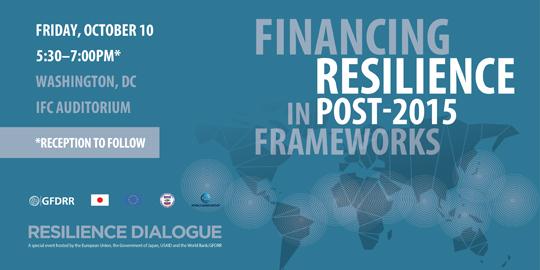How Can Innovative Financing Solutions Help Build Resilience to Natural Disasters?

This week, the Resilience Dialogue, bringing together representatives from developing countries, donor agencies and multilateral development banks, will focus on financing to build resilience to natural disasters.
There is growing recognition that resilience is critical to preserving hard won development gains. The share of development assistance supporting resilience has grown dramatically in recent years. New instruments have emerged in particular to help client countries deal with the economic shock of natural disasters. In this context, an important question is which financial instruments best serve the needs of vulnerable countries? Only by customizing instruments and tools to the unique circumstances of our clients, will we maximize development return on investments. Clearly, low-income countries with limited capacity may not be able to use financial instruments the same way middle-income countries can. Small island developing states subject to financial shocks where loss can exceed their annual GDP face vastly different challenges than large middle-income countries trying to smooth public expenditures over time or safeguard low-income populations against disasters.
The Pacific Catastrophe Risk Insurance Pilot is a good example of customizing financial instruments to a specific challenge. The six participating pacific states―Tonga, Cook Islands, Marshall Islands, Samoa, Solomon Islands and Vanuatu―have limited access to international capital and are highly exposed to fiscal shocks from disasters that overwhelm their budget or can even top their GDP. Through this initiative supported by the World Bank and the Government of Japan, these countries are able to pool their natural disaster risks into one single, diversified insurance portfolio, protecting their budgets while reducing the costs of accessing international insurance markets by 50 percent. Earlier this year, Tonga received more than $1.2 million in an immediate payout after Cyclone Ian swept across the nation’s Ha’apai island group displacing thousands and devastating crops and infrastructure. While this may not seem a lot in absolute terms, it was equivalent to more than the 2013 contingency budget or half of the current reserves of the Tonga National Reserve Fund.
For Colombia, a growing middle income economy, this amount would barely make a dent in its contingent liabilities. In 2011, Colombia became one of the first countries to integrate contingent liabilities from disasters in its overall fiscal risk management framework. While it calculated the potential loss from a catastrophic―1 in 250 years―event as up to $4,417 million, this is still only 1.4 percent of its 2012 GDP. Unlike small island states, a country like Colombia is not as much concerned with reducing immediate budget pressures following disasters, but to start tackling the underlying drivers of these losses. As a first step, it is now implementing international best practices as it insures $38 billion of new road infrastructure built through public-private partnerships.
Over the coming decade, trillions of dollars will be invested in new infrastructure. How can we ensure that investments in resilience are part of that? This will include continuing to promote new thinking, innovation and partnerships, especially with the private sector, in developing instruments to finance resilience. As delegations from around the world gather in Washington, D.C., for the World Bank Group/IMF Annual Meetings, this will be part of the conversation between decision-makers. What makes it an especially opportune time to elevate the issue of financing for resilience is the impending renewal of key development frameworks including the successor to the Hyogo Framework for Action, the Sustainable Development Goals, and the new international climate agreeement, and the need to weave financing for resilience into them.
This is the seventh instance of the Resilience Dialogue, which is organized by the Global Facility for Disaster Risk Reduction and Recovery (GFDRR), in partnership with the World Bank, European Union, the Government of Japan, and USAID.